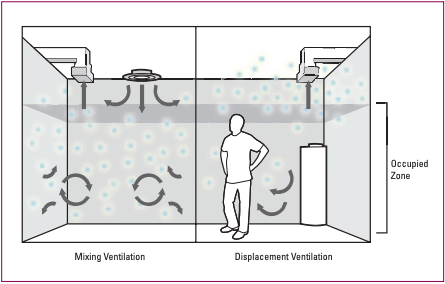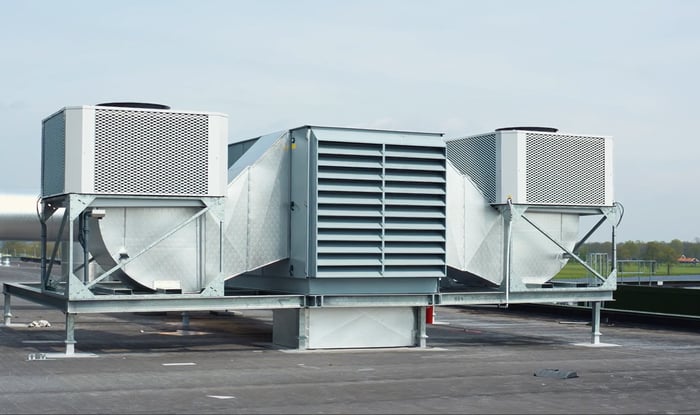Practice shows that the outside temperatures are on a constant rise during spring and summer, and factory workers are suffering more and more due to the resulting increased temperatures within their production facility. However, production facilities often have a limited form of ventilation and very rarely a mechanical cooling installation to control the indoor climate. If a factory already has ventilation, it is usually only based on extraction and therefore warm outside air is sucked in during summer. As a result, the heat problem is not solved, and sometimes even worsened.
In this blog, we will discuss how to rethink the ventilation within your production facility and what possibilities there are to upgrade your ventilation system to provide a comfortable, healthy and cool work environment.
Adding cooling to the air handeling unit
If there’s already an existing ventilation system in place, cooling can simply be achieved by placing a cooling system before or after the air handling unit, also known as AHU. The cooling system will cool down the air that runs through the ventilation system, while the air handling unit still provides extraction. However, it is most important to think about what type of cooling system you will be using. Conventional cooling technologies not only consume a lot of energy but also continuously dehydrate the air. This is most disadvantageous as a humidity level between 40 and 60% reduces the spread of dust and viruses. Placing a cooling battery connected to a chiller in the air handling unit can also be an option for added cooling. However, this requires the fans in the air handling unit to be adjusted to more powerful versions as well. And although the battery can be switched off when cooling is not necessary, the increased resistance of the heat exchanger has to be accounted for all the time, which in turn cost more energy.
A better option for instance would be to upgrade the ventilation system with Oxycom’s IntrCooll before or after the air handling unit. Oxycom’s unique two-stage evaporative cooling technology uses the natural cooling power of water evaporation and users save up to 90% of energy costs in comparison with conventional cooling technologies.
To give an example in the massive discrepancy in energy consumption between conventional air conditioning and Oxycom’s two-stage evaporative cooling: two calculations were made for an upgrade in the ventilatory system of a metal processing factory. If the factory were to opt for a traditional cooling solution, 100 kWh was needed to deliver the desired cooling. On the other hand, Oxycom’s two-stage evaporative cooling could provide the same cooling and maximum ventilation for less than 10 kWh.
Displacement ventilation
In the past, we would not look at the total cost of the ventilation installation so much as at the placement of the ventilation ducts. Naturally, these would be placed up high in the building so that the ducts would not get in the way of other things. However, when ventilating from the top-down, also known as mixed ventilation, the entire content of a building needs to be ventilated to feel the cooling effects of the ventilation on the ground. That being said, humans are only around 2 meters tall at the most, so most of the energy that is spent on cooling any building with mixed ventilation is wasted. Due to the mixing of hot and cold air before it reaches employees present in the workplace. So let’s rethink the position from which we ventilate. The fresh cold air should be delivered from the lowest possible position. For instance if a building is 7 or 8 meters high the air should be delivered preferably from around 3 meters from which the cold air can easily reach the work space.
A different approach would be displacement ventilation. With displacement ventilation, the building is ventilated from the ground up. Displacement ventilation blows fresh air horizontally over the shop floor and pushes the warm used air upwards, and expels it through the ventilation exhaust. In this way, less cooling power is needed to provide the room with a comfortable temperature. As an example, a calculation for a customer was made for the required cooling in a large production facility for which 26 IntrCooll units were needed in a mixed ventilatory system. In contrast, only 16 IntrCooll units were needed using displacement ventilation, resulting in a major cost reduction and of course even lower energy costs while cooling.
An added benefit of displacement ventilation is that as the clean air rises up, it pushes out the polluted air, taking with it viruses and harmful substances. With displacement ventilation, the content of hazardous substances in the air is reduced by 50 to 90 %.
 Price Industries "displacement ventilation" Engineering Guide
Price Industries "displacement ventilation" Engineering Guide
If it fits the building, it is highly recommended to use displacement ventilation. Not only does displacement ventilation minimize the level of air pollution, but it also costs significantly less energy than mixed ventilation to achieve the desired temperature.
In conclusion, a ventilation system can easily be upgraded by adding the IntrCooll before or after the existing air handling unit. This ensures that the air that is blown into a building is cooled down when necessary while still making use of the exhaust in the air handling unit. Oxycom’s IntrCooll provides the most energy-efficient solution to provide this added cooling. If possible, it is highly recommended to consider the use of displacement ventilation, as this ventilates harmful substances up and out of the building, while substantially lower investment and significantly less energy is needed.
Click here to learn more about the sustainable IntrCooll.
Free and tailored advice on a sustainable indoor climate
Are you currently dealing with the challenge of creating a comfortable, healthy and sustainable climate in your factory? Oxycom is here to help. Get free and tailored advice from one of our advanced adiabatic cooling specialist.





